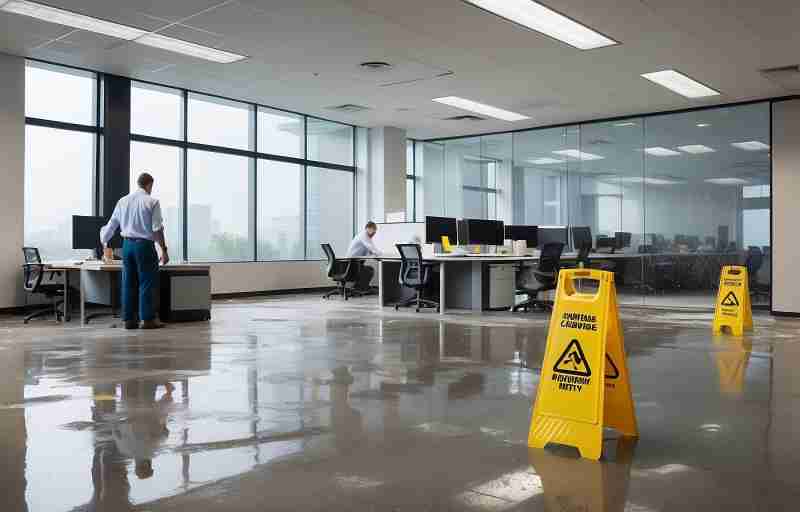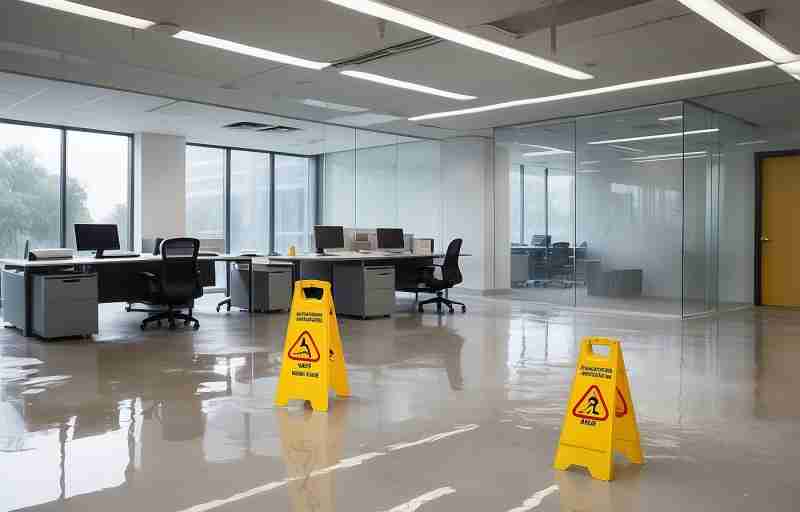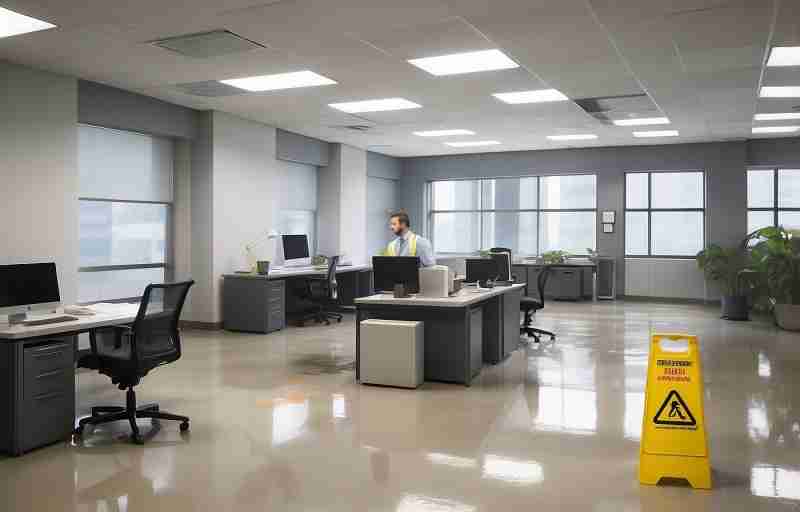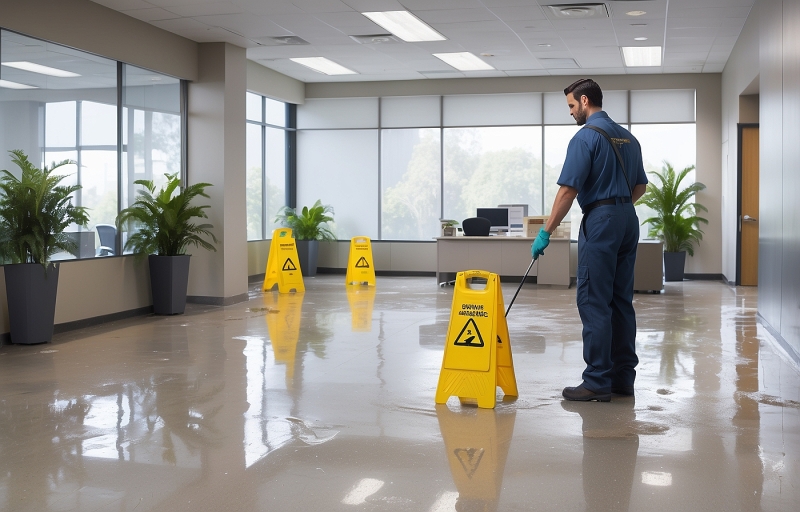Water damage in office buildings can lead to costly repairs, business interruptions, and potential health hazards if not addressed promptly and professionally. Whether caused by burst pipes, roof leaks, or natural disasters, knowing how to handle water damage in office buildings is essential for maintaining a safe and productive work environment. At COMMITTED TO QUALITY SERVICE, we specialize in fast, friendly, and professional water damage restoration. Our expert team uses advanced equipment specifically designed to dry and restore structures affected by severe water damage. From initial assessment to complete restoration, we ensure minimal disruption to your business operations. Don’t let water damage compromise your workplace—call us now at 855-933-7935 for immediate assistance. We also offer comprehensive fire damage restoration services to help you recover quickly and efficiently. Trust us to protect your property with quality service you can count on.
Identifying the Source of Water Damage

Identifying the source of water damage in office buildings is a critical first step in mitigating further destruction and ensuring a safe, functional workspace. Water damage can originate from various sources, and pinpointing the exact cause helps streamline the restoration process and prevent future incidents.
Common causes include leaking roofs, burst pipes, faulty HVAC systems, and even natural disasters like floods. According to the Environmental Protection Agency (EPA), “even small leaks can waste up to 10,000 gallons of water annually,” which can lead to significant structural and financial damage if left unchecked.
“Early detection and accurate identification of water damage sources can reduce repair costs by up to 40%,” according to the Insurance Information Institute.
To effectively identify the source of water damage, consider the following steps:
- Inspect ceilings and walls for discoloration or bubbling paint.
- Check around windows and doors for signs of moisture intrusion.
- Examine plumbing fixtures and appliances for leaks or corrosion.
- Review HVAC systems for condensation or drainage issues.
- Use moisture meters or thermal imaging to detect hidden water damage.
For more in-depth guidance, visit our detailed guide on how to identify hidden water damage early.
If you’re unsure where to begin, our expert team at Projekt Restoration is here to help. Learn more about our comprehensive services or explore our about page to understand our commitment to quality restoration.
For further reading, the American Red Cross offers a helpful resource on how to prepare for and respond to water-related emergencies: https://www.redcross.org/get-help/how-to-prepare-for-emergencies/types-of-emergencies/flood.html.
Assessing the Extent of the Damage
Before initiating any restoration efforts, it’s crucial to thoroughly evaluate the scope of water damage in your office building. This step helps determine the severity of the issue and guides the necessary actions for effective recovery. Begin by inspecting all affected areas, including walls, ceilings, floors, and office equipment. Pay close attention to signs of hidden moisture, such as discoloration, warping, or a musty odor, which may indicate deeper structural issues.
Utilizing moisture detection tools and thermal imaging can help identify water intrusion that isn’t visible to the naked eye. It’s also important to assess whether the water damage is confined to one area or has spread to multiple sections of the building. This will influence the restoration timeline and the resources required.
If the damage is extensive, it’s advisable to consult professionals who specialize in water damage restoration. They can provide a comprehensive assessment and recommend the best course of action. Additionally, reviewing the company’s services can help you understand the full range of solutions available for your situation.
Accurate damage assessment not only helps in planning the restoration process but also plays a vital role in insurance claims. Documenting the damage with photos and detailed notes will support your claim and ensure a smoother recovery process. Taking swift and informed action can significantly reduce long-term costs and prevent further complications.
Immediate Steps to Minimize Further Damage
When water damage strikes an office building, taking immediate action is crucial to prevent further structural deterioration and costly repairs. The first step is to identify and stop the source of the water intrusion, whether it’s a burst pipe, roof leak, or flooding. Shutting off the main water supply and ensuring electrical systems are safe can help avoid additional hazards. Next, remove any standing water using pumps or wet vacuums, and begin drying out the affected areas with fans and dehumidifiers to inhibit mold growth.
It’s essential to document the damage with photos and detailed notes for insurance purposes. Salvage important documents and electronics, and relocate undamaged furniture and equipment to a dry area. Contacting a professional restoration company ensures a thorough assessment and a tailored recovery plan. At Projekt Restoration, we offer comprehensive solutions to mitigate water damage and restore your office to its original condition.
Understanding the early signs of hidden water damage can also help prevent future incidents. Visit our guide on how to identify hidden water damage early for more insights. Acting quickly not only minimizes damage but also reduces downtime, helping your business resume operations as soon as possible.
Notifying Insurance and Documenting the Damage

Once water damage is discovered in an office building, promptly notifying your insurance provider is a critical first step. Delays in reporting can lead to complications with your claim or even denial of coverage. Be prepared to provide detailed information, including the date and time of the incident, the suspected cause, and the extent of the damage. It’s advisable to review your policy beforehand to understand what is covered and what documentation is required.
Equally important is thoroughly documenting the damage. Take clear, high-resolution photos and videos of all affected areas, including walls, ceilings, floors, furniture, and equipment. Keep a written inventory of damaged items, noting their approximate value and condition before the incident. This documentation will serve as vital evidence during the claims process and help restoration professionals assess the scope of work needed.
In addition to notifying insurance and documenting the damage, consider reaching out to a professional restoration company that specializes in water damage recovery. These experts can assist with both the cleanup and the insurance process. For more insight into the restoration process, visit our how-it-works page.
Taking immediate action not only protects your financial interests but also helps minimize long-term structural and health risks. For more information about our team and expertise, explore our about page.
Hiring Professional Restoration Services

When facing water damage in an office building, time is of the essence. Hiring professional restoration services ensures a swift and effective response, minimizing downtime and preventing further structural or health-related issues. Certified experts have the tools, experience, and knowledge to assess the extent of the damage, extract standing water, dry affected areas, and restore your workspace to its original condition. Their comprehensive approach not only addresses visible damage but also targets hidden moisture that can lead to mold growth and long-term deterioration.
Professional restoration teams follow industry-standard protocols and use advanced equipment to ensure thorough water removal and drying. They also help with documentation for insurance claims, making the recovery process less stressful for business owners. Choosing a trusted company like Projekt Restoration means you’re working with specialists who understand the urgency and complexity of commercial water damage.
To learn more about the range of solutions available, visit our services page. If you’re curious about how we operate, our step-by-step process is outlined on the how it works page. For those concerned about potential hidden issues, our guide on how to identify hidden water damage early offers valuable insights. Don’t wait until the damage worsens—professional help is key to a safe and efficient recovery.
Preventing Mold and Secondary Issues
After water damage occurs in an office building, one of the most critical steps is preventing mold growth and other secondary issues. Mold can begin to develop within 24 to 48 hours of water exposure, especially in areas with poor ventilation or hidden moisture pockets. To avoid long-term structural damage and health risks, it’s essential to act quickly and thoroughly.
Begin by ensuring all affected areas are completely dried using industrial-grade dehumidifiers and air movers. Pay special attention to carpets, drywall, and ceiling tiles, as these materials are highly susceptible to mold. Regular inspections and moisture readings can help detect hidden dampness that may otherwise go unnoticed. For more detailed guidance, visit our how-to-identify-hidden-water-damage-early page.
In addition to drying, disinfecting surfaces and removing any contaminated materials is crucial. Professional mold remediation services can ensure that spores are eliminated and future outbreaks are prevented. It’s also wise to implement preventive measures such as sealing leaks, improving ventilation, and scheduling routine maintenance.
If you’re unsure where to start, our team is here to help. Learn more about our comprehensive services designed to protect your office building from long-term damage. Taking proactive steps now can save you time, money, and stress in the future.
Implementing Long-Term Prevention Strategies
To effectively manage water damage in office buildings, it’s crucial to go beyond immediate repairs and focus on long-term prevention strategies. These proactive measures not only protect your property but also reduce the risk of costly repairs and business disruptions in the future. Start by conducting regular inspections of plumbing systems, roofing, and HVAC units to identify potential vulnerabilities. Installing moisture detection sensors and maintaining proper drainage systems can also help prevent water accumulation and leaks.
Investing in professional maintenance services ensures that your building remains in optimal condition year-round. Consider working with experts who specialize in commercial restoration services to develop a customized prevention plan tailored to your building’s unique needs. Additionally, educating staff on how to recognize early signs of water damage can lead to quicker responses and minimized impact.
Another essential step is to stay informed about the latest prevention techniques and technologies. Our detailed blog offers valuable insights and tips to help you stay ahead of potential issues. Implementing these strategies not only safeguards your office environment but also promotes a healthier and more productive workspace. By taking a proactive approach, you can ensure the long-term integrity of your property and avoid the stress and expense of future water damage incidents.
In conclusion, effectively handling water damage in office buildings requires prompt action, thorough assessment, and a well-structured response plan. By identifying the source of the damage early, engaging professional restoration services, and implementing preventative measures, businesses can minimize downtime, protect valuable assets, and maintain a safe working environment. Regular maintenance and employee awareness are also key to preventing future incidents. Taking these proactive steps not only safeguards your property but also ensures business continuity and peace of mind.

